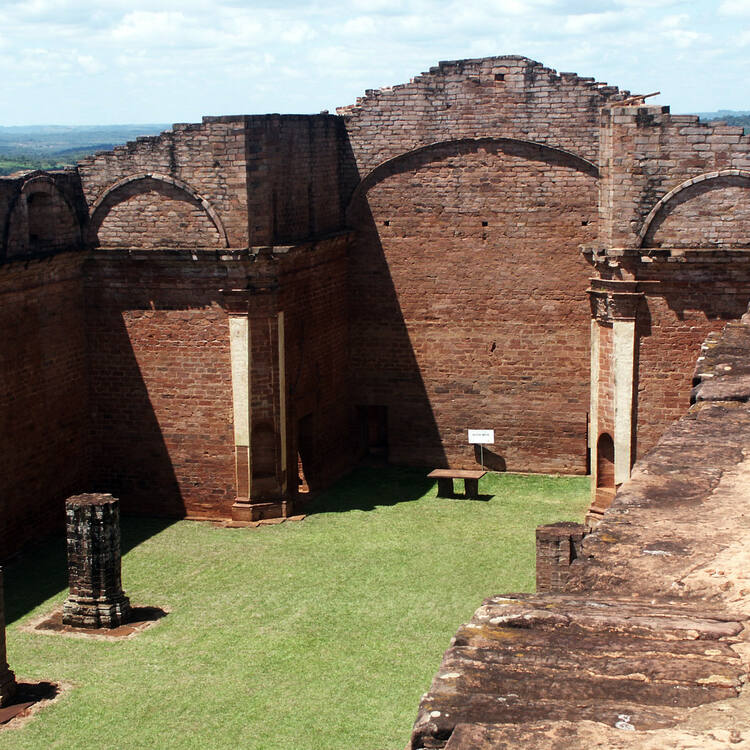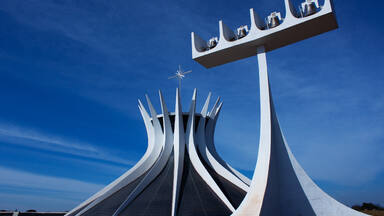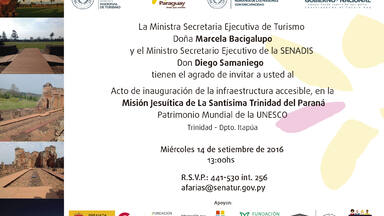Jesuit Missions of La Santísima Trinidad de Paraná and Jesús de Tavarangue
Jesuit Missions of La Santísima Trinidad de Paraná and Jesús de Tavarangue
In addition to their artistic interest, these missions are a reminder of the Jesuits' Christianization of the Río de la Plata basin in the 17th and 18th centuries, with the accompanying social and economic initiatives.
Description is available under license CC-BY-SA IGO 3.0
Missions jésuites de la Santísima Trinidad de Paraná et Jesús de Tavarangue
Outre leur intérêt artistique, ces missions représentent les initiatives sociales et économiques qui ont accompagné la christianisation du bassin du Río de la Plata par la Compagnie de Jésus aux XVIIe et XVIIIe siècles.
Description is available under license CC-BY-SA IGO 3.0
البعثات اليسوعية للسانتيزيما ترينيداد دو بارانيا وجيزو دو تافارانغ
تمثّل هذه البعثات، عدا عن اهتمامها بالفن، المبادرات الاجتماعية والاقتصادية التي رافقت نشر الديانة المسيحيّة في حوض ريو دو لا بلاتا على يد جماعة يسوع خلال القرنَيْن السابع عشر والثامن عشر.
source: UNESCO/CPE
Description is available under license CC-BY-SA IGO 3.0
塔瓦兰格的耶稣和巴拉那的桑蒂西莫-特立尼达耶稣会传教区
除了在艺术方面的贡献之外,公元17世纪至18世纪天主教耶稣会的传教机构在银河盆地不仅传播了对基督的信仰,而且带来了社会和经济的发展。
source: UNESCO/CPE
Description is available under license CC-BY-SA IGO 3.0
Иезуитские миссии Ла-Сантисима-Тринидад-де-Парана и Хесус-де-Таваранге
Помимо того, что эти миссии представляют художественный интерес, они ещё и служат напоминанием о христианизации иезуитами бассейна реки Рио-де-ла-Плата в XVII и XVIII веках с сопутствующими этому процессу социальными и экономическими мероприятиями.
source: UNESCO/CPE
Description is available under license CC-BY-SA IGO 3.0
Misiones jesuíticas de la Santísima Trinidad de Paraná y Jesús de Tavarengue
Además de su interés artístico, estas misiones son representativas de las iniciativas sociales y económicas que acompañaron la cristianización de la cuenca del Río de la Plata por parte de la Compañía de Jesús en los siglos XVII y XVIII.
source: UNESCO/CPE
Description is available under license CC-BY-SA IGO 3.0
ラ・サンティシマ・トリニダード・デ・パラナとヘスース・デ・タバランゲのイエズス会伝道施設群
パラグアイ南部、アルゼンチンとの国境に近い、パラナ川北岸のイエズス会伝道所。ラ・プラタ地方に住む好戦的な部族であるグアラニー人のキリスト教化のために、17世紀にイエズス会は30カ所のレドゥシオン(インディオ教化集落)を建設した。この独自の社会組織である集落には、数千人のインディオが生活し、19世紀末まで全体が一つの独立国家であるイエズス会国家を形成していた。source: NFUAJ
Jezuïtische missieposten van La Santisima Trinidad de Paraná en Jesús de Tavarangue
Deze artistiek waardevolle missieposten vormen een herinnering aan de kerstening van het stroomgebied van de Río de la Plata door de Jezuïeten in de 17e en 18e eeuw. La Santísima Trinidad – de meest ambitieuze missiepost en hoofdstad van de Guayrá – werd in 1706 gebouwd door de bekende jezuïtische architect Juan Bautista Primoli. Het heeft de best bewaard gebleven stedelijke structuur met onder andere de Plaza Mayor, een hoofdkerk en een kleine kerk, een school en klooster en begraafplaatsen. De kerk van Jésus de Tavarangue is vervallen – er resteert slechts een schoolruimte – maar heeft zijn imposante verschijning behouden.
Source: unesco.nl
Outstanding Universal Value
Brief synthesis
Jesuit Missions of La Santísima Trinidad de Paraná and Jesús de Tavarangue are part of a series of 30 missions in the Río de la Plata basin established by the Society of Jesus (the Jesuits) during the 17th and 18th centuries. Seven of these missions were located in Paraguay and the rest in the present-day countries of Argentina and Brazil. The mission complexes were attached to reducciones (settlements) and are evidence of a unique urban scheme. While each period had a singular style, all combined indigenous elements with Christian attributes and symbolism exhibiting Baroque, Romanesque and Greek influences, as part of an unprecedented process of acculturation.
The Jesuits arrived in the Guayrá in 1588. With the permission of King Philip II of Spain, the missionaries’ goal was to Christianize the indigenous population as well as to protect them from the colonial labour system of encomienda, a condition of virtual slavery. The inhabitants were brought together and encouraged to adopt a sedentary form of life and the Christian religion but unlike other missions in the New World, they were not forced to “Europeanize”. Many indigenous traditions were retained and encouraged such as the cultivation of yerba mate (Ilex paraguarienses - te jesuita), which continues to be a representative regional product today.
The missions are located about 10 kilometres apart and each is surrounded by its own buffer zone. Although today the missions are essentially archaeological ruins, their original layout followed, generally, a similar form with the church providing the basic unit, the urban core and the centre of spiritual life. Next to the church stood the residence of the Fathers, with the houses of the Caciques close by. The rest of the mission was composed of the yard, cloisters of workshops, garden, the Tupa Mbaé, cemetery, and jail. Adjacent to the church, there was a large square facing the four cardinal points, with crosses or statues and shrines in the four corners. Streets 16 or 18 meters in width radiated from the squares. The houses for the indigenous residents were arcaded blocks 60 meters square.
The Mission of Santísima Trinidad del Paraná stands as the best preserved urban complex. Although it was established in 1706, later than many of the reducción, it was also the most ambitious of the missions with a complex of buildings covering an area of about 8 hectares. The large stone church had a fine dome and impressive decoration. It was built around 1745 according to the design of the Milanese architect Juan Bautista Prímoli. In addition to the main church, evidence survives of the small church, college or school, cloister, cemeteries, kitchen gardens, belfry, native houses, and workshops.
The urban structure of Jesús de Tavarangue survives as an archaeological ruin. This reducción was founded at a different location in 1685 and moved a few years later to this site when the mission was built. It consisted of the church (which remained unfinished), the Major Square, the school attached to the church of which only one room survives, and houses for orphans and widows known as Coty Guazú or Great House. The mission also had an orchard for priests.
The Mission of Jesús de Tavarangue as an architectural expression is characterized by the combination of architectural styles. The Mudéjar (Christian-Arab) style is especially reflected with the use of the trefoil arch. There are no other architectural examples of this style, from the Jesuit era, in the region that formerly constituted the Province of Paraguay or Paracuaria.
Criterion (iv) : La Santísima Trinidad de Paraná and Jesús de Tavarangue are exceptional examples of the Jesuit missions built in the 17th and 18th centuries throughout this region. The archaeological ruins of these urban complexes represent a fusion of cultures in which the process of Christianisation permitted the indigenous population to retain elements of their traditional culture.
Integrity
The property consists of two reducción ruins each containing the components of the original complex: churches, apartment buildings, schools, shops and open spaces like gardens and orchards. The sites have survived as archaeological ruins, as they were left in the period when the Jesuits were expelled in the 18th century. The delineation of the proposed area includes all components necessary to express the outstanding universal value.
Threats to the properties appear to be primarily due to “atmospheric attack” such as storms and occasionally tornadoes. Each of the two components of this property is surrounded by modern communities and threatened with urban development pressure if not appropriately managed. This is especially apparent with the rapid development of the neighbourhood surrounding La Santísima Trinidad where a screening of trees has been suggested. In 2003, an interdisciplinary expert team visited Jesuit Missions in Paraguay as well as in Brazil and Argentina. The report presented to the World Heritage Committee identified several challenges to the series of properties including the potential for tourism pressure, the lack of capacity in conservation techniques, lack of financial and human resources and the lack of management including legislation.
Authenticity
Both components of this inscription have retained authenticity of form and design because evidence of the original mission layout is visible as are the buildings. The abandoned complexes and churches are no longer used for their original purposes.
Authenticity has been carefully considered in work done on the sites, specifically at La Santísima Trinidad, where restoration and consolidation has been based on a detailed survey of the remains visible above the surface and an archaeological study of buried evidence. At Jesús de Tavarangue stabilization work has taken place at the college and the archaeological site has been cleared.
Protection and management requirements
The ownership of the reducciónes of La Santísima Trinidad and Jesús de Tavarangue is with the Dirección General de Turismo of the Ministerio de Obras Públicas y Comunicaciones which is responsible for the management of the properties. Custody, protection, and responsibility for conservation were defined by a Letter of Intention in August 1993, through the Sub-Secretariat of Culture within the Directorate General of Cultural Heritage and the Vice Ministry of Culture and the Directorate General of Tourism (presently the National Secretariat of Tourism).
While no specific legal protection for the inscribed property has been identified, various plans have been approved including the Archaeological Survey Plan, the Plan for the Preservation of the whole Mission and an Annual Management Plan. A management plan for La Santísima Trinidad de Paraná was completed in October 2011 and the management plan for the Mission of Jesus is under development.
Various restoration projects undertaken at La Santísima Trinidad since 1980 have focused on repairing damaged buildings. Moreover, in response to the 2003 report to the World Heritage Committee, conservation workshops were held (2003-05) resulting in the “Conservation Manual Jesuit-Guaranies Missions” which is used by the missions in the region. Moreover, the meetings of MERCOSUR CULTURAL provide a forum for dialogue between countries.


